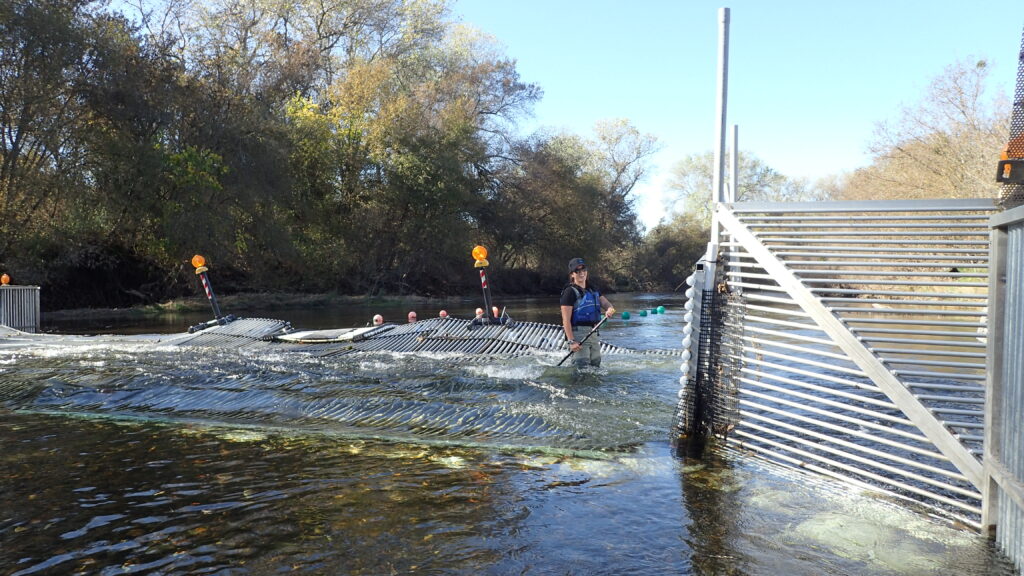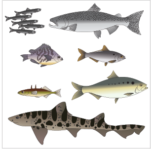
For more than two decades, steelhead — listed as federally threatened in 1997 — have been monitored throughout the state. However, until recently that monitoring has been a haphazard affair. Each local jurisdiction has established a different system, using different methods with different degrees of intensity, according to a 2018 study examining monitoring within the Central Valley and its environs. In some areas, primarily the Sacramento River watershed, which drains the vast northern part of the valley, data has been collected more comprehensively. In other areas, such as the San Joaquin River system to the south, more gaps remain. And in general, monitoring tended to focus solely on migrating numbers and not more detailed life history demographics.
“We need to improve our understanding of the population status throughout the Central Valley — not just in terms of abundance but also demographics such as age, sex, and size,” says Michael Beakes, senior fish biologist with the U.S. Bureau of Reclamation Bay-Delta Office Science Division.
A look at watersheds at two different ends of the Estuary reveals two different monitoring stories: one from the nearly 330-mile-long San Joaquin river, which has its headwaters in the snow-capped Sierra Nevada mountains; and one from three small watersheds in the arid and urbanized South Bay hills of Santa Clara, which center on 66-mile-long Coyote Creek.
The word that keeps coming up when discussing steelhead monitoring in the San Joaquin watershed is: complicated.
The landscape itself is complex. Draining nearly 20,000 square miles and yielding an average annual surface runoff of about 1.6 million acre-feet of water a year, the San Joaquin is a massive system with many tributaries, which traverses many ecosystems and runs through many jurisdictions. It has over 80 dams with a total storage capacity of more than 7.7 million acre-feet on the San Joaquin, Merced, Tuolumne, and Stanislaus rivers. The basin’s many rivers and streams not only sustain countless species and landscapes — both wild and developed — but also provide humans with water supply, recreation, and hydroelectric power.
The fish, too, are complicated. Different individuals in Oncorhynchus mykiss may remain in freshwater their entire lives, and be known as rainbow trout, while others from the same population — even from the same parents — will become anadromous and outmigrate to spend some years of their life at sea. Neither are the migratory individuals on a set schedule as far as when they will leave for and return from the saltwater portion of their lives, as other anadromous salmonids are. That flexibility likely gives them an adaptive advantage. When oceanic conditions are unfavorable, they may return inland; when life in the river is better or worse than usual, they can choose to stay or go. Some few individuals will even make the trip more than once, spawning in freshwater each time they return.
“There is still a lot that we don’t know, genetically and environmentally, about what dictates which of those pathways the fish ends up on,” Beakes says. “So because of that we also don’t know what management actions we should take to boost the anadromous portion of the population. If we want to move towards steelhead recovery, we need to get a better handle on how much life-history variation there is and what factors drive fish to take on one life-history type over another.”
Since 2020, the Bureau of Reclamation has been working to ensure that its monitoring program will be able to answer some of these questions. In addition, a new multi-agency steelhead monitoring plan currently being developed for the San Joaquin basin aims to make all this complexity more manageable. Last January, a three-day online workshop on steelhead monitoring in the San Joaquin basin was hosted by the Delta Stewardship Council, with the goal of facilitating this process. It was attended by roughly 200 people.
“This is a specific goal that we are pursuing — participation by the other agencies is optional, but obviously, they are supportive of this conservation effort,” says Beakes, the plan’s lead author. “’Plan’ is a bit of a misnomer, since there is no regulatory mechanism. It really is more intended to be a well-organized informational packet: here is what we know, and here are the best tools and approaches that we can use to evaluate this species.”
He added that a similar plan, developed by the California Department of Fish and Wildlife, already exists for the Sacramento River system. “We are trying to create a complimentary plan, expand on some of the concepts, and reach out to stakeholders on the Sacramento side as well. It makes sense to leverage our collective knowledge and work together on some of these management issues.”

Meanwhile, out on the rivers, the boots-on-the-ground work continues to unfold and expand.
On the Stanislaus alone, researchers are collecting scale and genetic samples to find out which adults are effective at reproducing, how much gene flow occurs between systems, and how old the fish are. They’re using this data in combination with an existing PIT (passive integrated responder) tag program, in which microchips are implanted in fish and later scanned as the fish swim over an antenna installed in the river channel. In-stream spawning surveys, where researchers look for active spawning and also collect carcasses, are conducted by boat. Researchers also capture outmigrating fish using rotary screw traps. Steelhead that reach the Delta are monitored by the U.S. Fish and Wildlife Service.
In the future, more changes will be made to the monitoring program, Beakes adds. On the Stanislaus, they hope to install a new rotary screw trap and modify its configuration to target steelhead. And they are in the early stages of a partnership with Oregon State University and the U.S. Geologic Survey to develop a lifecycle model using the steelhead data being collected on the Stanislaus.
“Steelhead have a lot of cultural relevance, so they serve a lot of anthropogenic needs and ecosystem needs,” Beakes says. “That complexity is fascinating, but it presents a major challenge from a management standpoint. We’re just starting to understand exactly how complicated this species is.”
Much farther to the south, in Santa Clara’s Guadalupe River, Coyote Creek, and Steven’s Creek watersheds, local scientists are also centering steelhead — but in a very different way. Draining just shy of 500 square miles combined, these watersheds have many tributaries that are affected by summer low flows and droughts. Downtown San Jose straddles the lower reaches of the Guadalupe Watershed, so migrating steelhead — and the humans monitoring them — must navigate detritus and effluent from homeless camps before reaching their destination.
“Some seasons we will detect very few steelhead,” says Clayton Leal, senior water resources specialist in the Environmental Mitigation and Monitoring Unit at Valley Water, formerly known as the Santa Clara Valley Water District. “We are very arid and the drought has hit our systems hard.”
With small numbers of detection, it is hard to generate outside interest in the program. “We’ve been told by some research organizations that our county isn’t scientifically interesting because we have small populations,” Leal says.
But to Leal and his team, every steelhead is important to the degree that, when the first monitoring effort ended in 2013, they applied to not only continue but also expand the program, collecting a wider range of data from a greater number of creeks.
“These are a federally threatened species, and they are a keystone species in the environment,” Leal says. “These fish need good water quality; if they persist then we know we are maintaining a healthy ecosystem.”
The water district’s early monitoring program — launched in 2004 — focused on habitat conditions and numbers of juvenile steelhead within the mainstem of the Guadalupe River, and in Guadalupe Creek. The new program includes the Stevens Creek and Coyote Creek watersheds. They now not only collect data on juvenile rearing, but have expanded to include adult and juvenile migration, fish condition, and survival. “We want to know about all portions of the fish’s life history,” Leal says.

They added an automatic fish counter called a Vaki River Watcher to three creek systems. Leal likened the counters, which are mounted within fish ladders, to copy-machine scanners for fish. And as in the Stanislaus system, Valley Water uses PIT tags, as well as conducting other habitat surveys.
“Really the only difference that you’ll see in monitoring in these small urban watersheds versus bigger rivers is scale,” Leal says. “We use a lot of the same technology.”
In this watershed, the fluctuations in returning steelhead can be dramatic, largely based on environmental conditions: abundant in wet years, diminished during droughts. “In 2015 we actually caught zero juvenile steelhead, which was a shock,” Leal says. In 2016 they caught two, and in 2017, after record-setting rains, they caught 30.
“With the monitoring, we’re also trying to understand what we can do – for example, how water from reservoirs can be released in a more beneficial way for the fish, all while still providing water to the two million people who depend on it,” Leal says. One thing the water district has tried is to maintain a “cold pool volume” so that the reservoir will remain deep enough to stay colder, thereby making the released water more beneficial to the steelhead.
In addition to drought, human degradation is also a big factor in fish health and creek quality. In Santa Clara County, the lower reaches of creeks are often urbanized, stripped of riparian vegetation, fished, and occasionally even informally dammed.
“The level of degradation is really extreme,” Leal says. “When you look at what these fish have to swim through — I tip my hat to them every time. It’s a tough life to be a fish in Santa Clara County, and they make it work. It’s pretty impressive.”
Top photo: Steelhead sampling on Guadalupe Creek near San Jose, in the South Bay. Photo: Valley Water
